24 Email Newsletter Ideas To Engage Your Subscribers
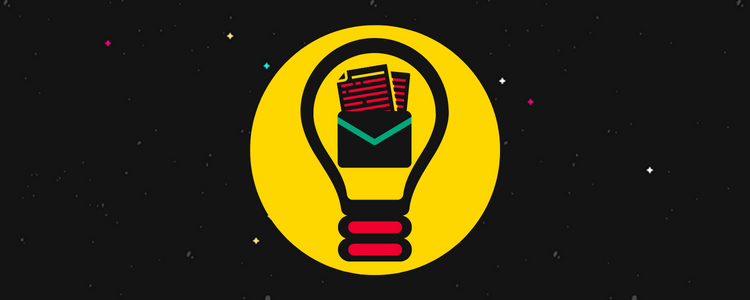
Struggling to think of ideas for your newsletter? No worries—we hear you.
In this post, you’ll find 20+ engaging newsletter ideas that you can use to give your email marketing strategy a boost. Real-life examples included.
Ready? Let’s jump into it.
1. Deals and promotions
Deals and promotions are among the most common types of content to include in email newsletters.
If you’re trying to generate leads and actively encourage people to join your mailing list, then offering an exclusive or limited-time deal in your newsletters is a great way to incentivize people to sign up.
Some promotions you can offer include discount codes and price reductions on certain products. You could even gamify your newsletter by including a wheel of fortune that users can spin to find out what offer they will be awarded. You can use email marketing tools like MailerLite to do this.
Here’s a great example from American Eagle:
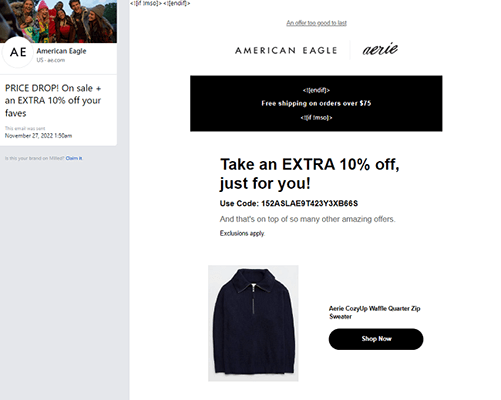
In this newsletter, the company offers a personalized discount to the customer for signing up, as well as detailing some other general offers and discounts that are available.
2. Recent or top-performing blog roundups
One of the easiest ways to create a useful and relevant newsletter is to repurpose content you already have from your blog. Although your mailing list has expressed interest in your content and signed up for your newsletter, they may not visit your site regularly.
Therefore, you can use your weekly or monthly newsletter to get them up to date on what they have missed. When creating blog post newsletters, it’s a good idea to select high-performing posts that are most likely to engage your readers.
Also, it’s important to ensure that readers can easily click through from the email to read the article in full, so make sure links of buttons are easily visible.
Here’s a great example from Look Fabulous Forever:

The email provides a snippet of the latest blog posts ‘from the blog’ and then gives readers a clear and easy way to navigate to the site to read more.
3. Infographics
Another great newsletter idea is infographics. Infographics are highly visual and make it easy for readers to digest detailed information. As such, they lend themselves well to an email format.
The good thing about infographics is that you can turn almost anything into one. Whether you want to display information on your latest sales figures, or you want to tell readers more about your brand’s message and goals, infographics are a great way to do it. Take this newsletter for example:

The company aimed to explain to users the benefits of choosing a luxury retailer over a larger retailer offering Black Friday discounts. They did this using an infographic rather than prose to help their readers understand the information better. It also made the newsletter a lot more visually interesting and engaging.
4. Yearly review newsletters
Particularly in December and January, a good newsletter idea is ‘Year in Review’. These types of newsletters detail everything that has happened with your business in the previous year.
You can include all the details about your company’s success throughout the year, information about new staff members, and even give readers a sneak peek at what is to come in the year ahead.
If you run a blog, you can also consider including some details of the most popular posts you had throughout the year and make sure to add links for anyone who hasn’t yet had a chance to read them.
Another nice touch is to thank your readers for sticking with you throughout the year and to wish them all luck with the year ahead.
5. User-generated content
If you’re struggling to come up with new content for your newsletter, then it’s a good idea to look at your website and social media accounts to see if you have any user-generated content that you can repurpose.
User-generated content like customer testimonials or product reviews and pictures can be used to curate a fun and engaging newsletter. Particularly if you are selling a product, then you can use pictures that your customers have posted to social media featuring your product.
This can function as a shoutout to your customers, but it can also provide inspiration to other readers on how to use or wear your products.
The great thing about UGC newsletters is that they’re quick to whip up, as most of the content has already been provided by your customers or readers.
6. Case studies
Another great idea for email newsletters is case studies. Case studies document the journey of a customer, usually to show the success that they have achieved using your product or service.
For example, the company Wise Pelican creates and distributes marketing postcards for real estate businesses. In their email newsletters, they detail accounts of different customers that have benefited from their service:
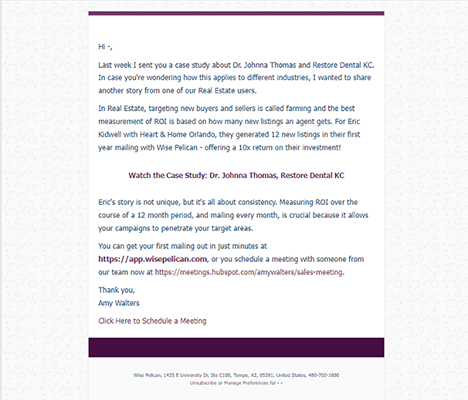
In their case studies email newsletters, they include a snippet of the case study story in the text and then link out to a full case study video.
What’s great about this type of email is that it advertises your products in an indirect but interesting way. It also provides evidence that your product or service is valuable and worthwhile.
7. Upcoming events
You can also create newsletters about events that you have coming up. Whether you’re hosting in-person marketing events or online webinars, it’s a good idea to let your mailing list know what is coming up, so that they can make plans to attend.
For example, the National Residential Landlords Association uses its newsletter to let its readers know about upcoming courses:
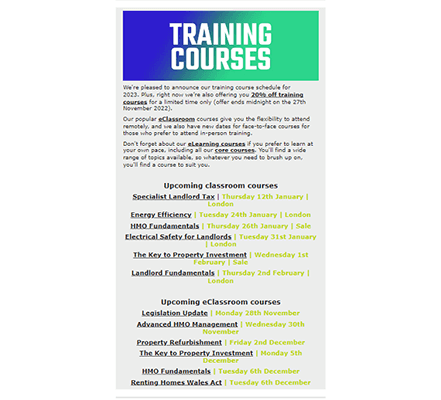
As you can see, they strategically link to each of the different courses so that interested readers can easily click through and sign up. It’s also a good idea to create different sections for in-person events and online events, just as the NRLA has done in this example. This helps readers to know exactly what they’re looking at, and they can easily navigate to the type of events they’re most interested in.
8. Relevant industry news
One extremely easy format for online newsletters is creating a news roundup of important articles in your industry.
What’s great about these types of newsletters is that they’re very quick to create, as you don’t really have to write a lot of content yourself. You can simply link out to news sites. Alternatively, you can link to articles published on your own site about industry news.
A great example of a newsletter covering industry news is this news round-up from Logistics Innovators:
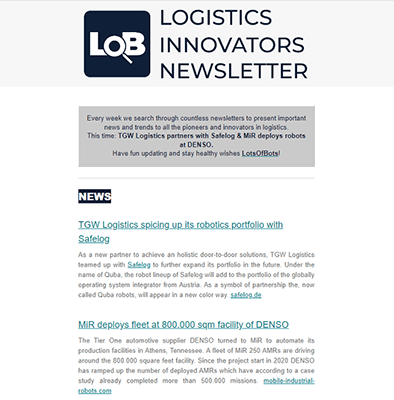
Each week, the company searches news outlets to compile important news and trends from professionals in the logistics industry. The email newsletter contains snippets of stories to hook readers and encourage subscribers to click through and read the full story.
9. News about your business
In the same vein as industry news, you can also use your newsletter to tell your customers important news updates about your business.
Maybe you’re planning to make updates to your current products or services, or perhaps you’ll be adding new products to your line.
This type of news lends itself well to a newsletter format. If you plan on writing a newsletter about your internal business news, then it’s a good idea to write some supporting blogs too, that go into more detail about each news item.
This way, you can provide a short synopsis of the story to your newsletter readers and then link out to the more detailed blog post so that they can learn more.
10. Recruitment opportunities
If you have any current vacancies or job opportunities coming up, it’s a good idea to distribute them in a newsletter. This way, your current vacancies will reach new audiences, and you may just find that the talent you are looking for is already a part of your mailing list.
If you have a few vacancies to add to your newsletter, it’s a good idea to provide the job title, plus a few key details of the job, such as the salary and location. Then, you can link out to the full job description so that interested parties can click through.
Here’s an example of a vacancy newsletter from the popular jobs board Remotive:
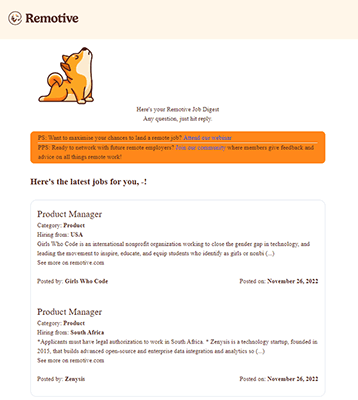
As you can see, they include only a small snippet of job information, such as the category, location, and hiring company.
11. Insider tips
Another way to create a newsletter that people will open is to provide insider tips that you may not have posted on your website.
You can use your subject line to make readers think that the information in the newsletter is secret or exclusive to people signed up for your mailing list.
Here are some examples of catchy subject lines that might pique the reader’s interest:
- ‘Psst… we’ve got a secret to tell you’
- ‘This insider secret changed the way we do business’
- ‘There’s something we need to tell you…’
However, if you want people to really engage with your marketing email then you also have to deliver on your subject line promise. So you should try and include new and relevant information that isn’t readily available on your website.
Be sure to make your tips insightful and actionable, so your readers don’t feel like they have been conned.
12. FAQs
If you’ve noticed that you’ve been getting a lot of the same questions from your customer via email, it may be a good idea to distribute an FAQ newsletter to address some of the most commonly asked questions.
You can create a general FAQ newsletter about your business or products, or you could zoom in and create an FAQ list for questions relating to particular products or services that you offer.
You can also create a newsletter based upon just one FAQ, like Performance Inspired Nutrition has done here:
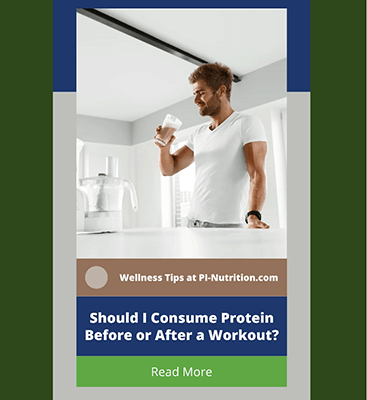
Whatever you decide to do, be sure to keep the answers to your questions brief so as not to overwhelm the readers. If your questions require longer answers, then you can also consider linking out to blogs that cover the answers to questions in more detail.
13. Industry surveys and reports
If your business has recently completed an industry survey or report, then it’s a good idea to turn it into a newsletter.
All you have to do is compile a condensed list of the report’s key findings, and this will form the basis of the body of your email. Then, add a link to the full report on your website, or provide a link to download the report in PDF format.
Findings from surveys and reports are extremely valuable, so it’s also a good idea to use this as an incentive to get people to sign up for your mailing list.
14. Listicle-style content
Another great way to fill out a newsletter email is to focus on listicle-style content. This format works particularly well for businesses that are selling physical products, as you can include your own products on the lists.
For example, if you sell wellness products, you could send newsletters like ‘10 best candle scents for the holiday season or ‘10 best body lotions for moisturizing’ and include your own products to market them.
Not only does this give you an opportunity to showcase your products, but you can also add value to your newsletter by providing some short reviews of the products you’ve included in your listicle content.
Alternatively, you could just create simple newsletters of your top pick products for that season like BrandAlley has done here:

15. Employee spotlights
Another fun newsletter idea is employee spotlights, particularly if you have new employees joining your team. You can use your newsletters as an opportunity to introduce them to your mailing list, and spotlight their personality and qualifications.
Equally, you can spotlight existing employees and highlight their achievements.
For example, you might want to spotlight your employee of the month and advertise what they have achieved and why they won. You may also want to spotlight the team behind the creation of a new product or service. Whatever you choose to do, make sure that the content is positive and celebratory of your employees. This will help your company to build a good reputation as a fair and responsible employer that cares about its staff.
16. Interviews
Exclusive interviews also make for great newsletter content. You can interview anyone, from your staff or CEO to clients and customers that have had success using your product.
When creating interview newsletters, try to include the interview highlights in your email, and then link out to the full version of the interview.
This way, readers will be hooked by the interesting points of the interview and be encouraged to click through.
17. Monthly recaps and updates
One of the most common topics for newsletters is monthly recaps or updates. These types of newsletters simply detail what has been happening at your company in the last month.
It might include information about new products and services, or even updates about important changes such as price adjustments or shipping changes.
If you have a mailing list of customers that need ongoing updates on what’s happening with your company, for example, if you run a subscription-based business or you have a lot of regular clients, then publishing a monthly recap newsletter can be a great way to keep your customers in the loop and engaged.
18. Webinar content
Email is one of the best channels for promoting webinars. You can use your newsletter to advertise upcoming online events and drive registrations.
Check out this example from Global Career:
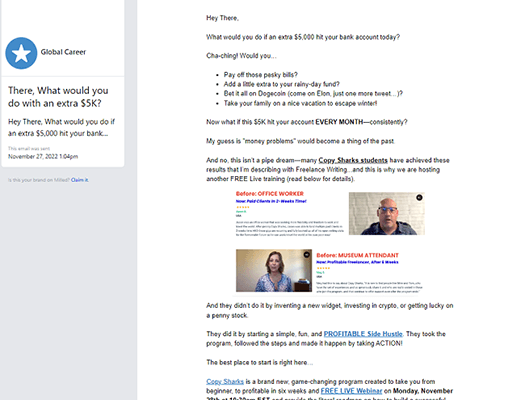
There’s a lot we can learn from the copy here. The subject line has been carefully crafted to hook the recipient in and get them to click open. It invites them to imagine how an extra $5k cash injection every month would change their life.
Then, when they’ve had an opportunity to fantasize, it invites them to sign up for a free webinar to learn how to make that a reality.
That said, it isn’t perfect. There’s a lot of text here, but pictures speak a thousand words. Try to incorporate more visual media in your newsletters and avoid walls of prose.
19. Holiday-related newsletters
If there is an important holiday coming up, it’s always a good idea to release a newsletter related to that holiday. For example, if it’s Christmas, then it’s a great idea to send a specific newsletter detailing everything that your business is doing in honor of the holiday.
This may be special discounts and sales, but you may also want to include information about any special events or in-house events that you may be having.
Alternatively, you can include links to holiday-related content from your blog, just as simple living hardware brand Lehmans have done in this example:
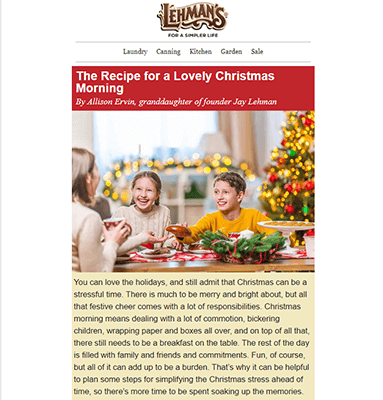
20. Guides for products or services
Newsletters aren’t just for promotional content.
Depending on what kind of product or service you’re selling, it might make sense to include instructional content in your email newsletters too, like guides and useful free resources.
This is particularly relevant if you’re selling a SaaS tool or app that has more of a learning curve than regular products.
Here’s a great example of the kind of thing we’re talking about from Mylio—a photo management app:

The newsletter offers a brief getting started guide to new subscribers, reminding them what Mylio Photos is and providing instructions on the next steps they need to take to use it.
The email includes links to both the app download page and the Getting Started page where users can find more detailed guidance.
21. Reviews and positive feedback
Positive reviews are one of the most powerful tools in your marketing arsenal. They serve as social proof that can have a big impact on potential customers’ purchasing decisions and give them the reassurance they need to hit buy.
So naturally, it makes sense to share your best reviews with the leads that are already in your sales funnel.
Try incorporating reviews from existing customers in your next promotional newsletter, like this example from DreamCloud UK:

As you can see, this newsletter leads with positive reviews. It puts them center stage and makes sure they’re the first thing recipients see when they open it up. Then right below the reviews, there’s a CTA button inviting customers to shop the sale.
22. CEO messages
As the highest-ranking executive in the company, your CEO is very much the public face of your brand. People look to the CEO for important updates, especially in times of uncertainty.
For example, many brands sent out newsletters with a message from the CEO during the initial outbreak of the COVID-19 pandemic to offer reassurance to their customers and keep them in the loop about what the business is doing behind the scenes to adapt during those uncertain times.
If nothing else, a message from the CEO can be a great way to humanize your brand, connect with your customers on a personal level, and show them that you care.
Here’s an example from RealSteel Center:
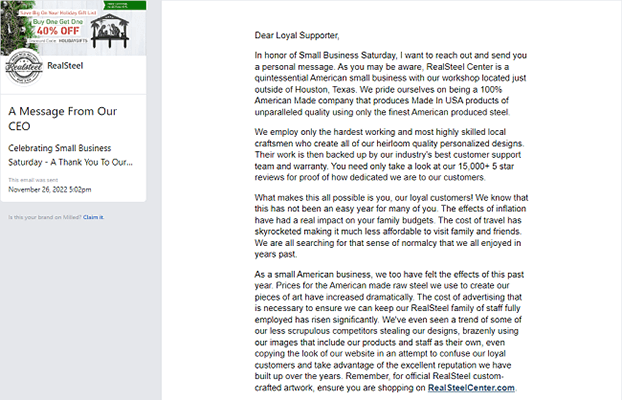
In this newsletter, the CEO sent a well-thought-out message in honor of Small Business Saturday.
They used it as an opportunity to highlight the brand’s biggest selling points, advertise new designs, and promote offers and loyalty rewards programs, all the while showing appreciation for their supporters.
23. Thank you messages
Every now and then, it’s important to reach out to your customers and thank them for being a part of your company, and your mailing list.
Many companies choose to do this type of email newsletter during the festive period or around the new year but it can really be done anytime.
Thank you newsletters are a great idea if you are running low on content for your newsletters.
You can simply write a short message thanking your customers for their loyalty, and you can also detail some of the things that they have helped your company to achieve over the past year.
It’s also a good idea to include a discount code in these types of emails, as this will incentivize people to remain part of your mailing list.
Overall, it’s a great way to make a good impression on your customers, and make them feel recognized.
22. Contests and giveaways
Running a contest is a great way to drum up excitement around your brand and generate new leads for your business.
It works like this. First, choose a prize (a product freebie is a great option) and then use a giveaway tool like SweepWidget to set up the entry conditions and create your contest.
Then, host your giveaway on a landing page and send out a newsletter or email blast to your newsletter subscribers with a link to enter.
It’s up to you what you set as the entry conditions. For example, you could require users to share the contest with their friends, or like your social media page to enter. Or you could make entry only available to your email subscribers to encourage readers to join your list.
Once your giveaway campaign is finished, send out another email announcing the winner. And use it as an opportunity to promote your products or services.
24. Celebrate a milestone
Another cool idea is to incorporate emails that celebrate key milestones for your business in your newsletter.
For example, you could send out a special unique newsletter message to mark the 1-year, 5th, 10th, 50th, or 100th anniversary of your brand.
Or you could send out a newsletter to mark the date on which you reached a certain number of sales or customers. For example, 10,000 customers, or $1 million in sales.
If you’ve been running a pre-sale for a new product release, you could send out a newsletter to celebrate when the first batch is sent out. You get the idea.
Celebrating milestones with your target audience makes your customers feel like they’re part of the journey with you and can help boost brand loyalty.
Final thoughts
That includes our roundup of email newsletter ideas.
Hopefully, this post has given you some food for thought and provided you with fun newsletter content ideas to use in your next email marketing campaign.
If you haven’t got a list to send out your newsletters to yet, check out our ultimate list building guide to find out the most powerful strategies you can use to collect sign-ups.
And remember, newsletters aren’t the only type of email you should be sending. Click here to find out more about the 5 types of emails every business should include in its marketing mix.
Further reading:
- 13 Top Email Newsletter Software Tools (Comparison)
- 28 Email Sign Up Form Examples You Can Learn From
- The Top Email Marketing Statistics You Need To Know
Disclosure: Our content is reader-supported. If you click on certain links we may make a commission.
